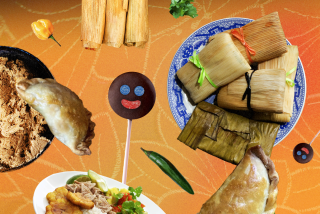Bay of Pigs: a Backwash to Birthday
- Share via
BAY OF PIGS, CUBA — The Cubans do not call it the Bay of Pigs. That is a name fit for a fiasco, not for a historic victory, a name to be used by the Yanquis , whose fiasco it was.
The Cubans instead name it after Playa Giron, the main beachhead at the eastern entrance to the bay where, in a three-day battle 25 years ago this week, they defeated an invasion force of exiles armed, trained and directed by the U.S. Central Intelligence Agency.
Most often, the battle is simply referred to as Giron, an event the Cubans regard as their Valley Forge, Verdun, Stalingrad or Battle of Britain. A huge billboard on the approaches to the beachhead depicts a sinking ship aflame and a defending tank rolling into action. “Playa Giron,” it reads, “the first great defeat for imperialism in Latin America.”
Historically, this is not quite correct. A much earlier major defeat for regional imperialism was, ironically enough, the work of the Yanquis themselves: In 1867, flexing his military muscles in the wake of the Civil War and invoking the Monroe Doctrine, President Andrew Johnson forced the French Emperor, Napoleon III, to withdraw his army from Mexico.
But such pedantry has no place in propaganda and in a 20th-Century context, providing you can swallow the word “imperialism,” Castro’s billboard tells a plain-enough truth: the Bay of Pigs was the first major defeat for U.S. policy in this hemisphere--and one that continues to reverberate a generation later.
Playa Giron nowadays is more than a triumphant symbol of Cuban revolutionary independence; it is also an unintentional symbol of the country’s economic plight. Squeezed by classic Marxist mismanagement, U.S. economic embargo, plummeting world sugar prices--and thereby desperately short of hard currency for essential imports--the Castro regime is trying to turn Playa Giron into a resort for foreign visitors.
The hotel complex Castro created here as a recreation area for Cuban workers has been turned over to the state-run tourist organization, Intur, and the concrete cabanas fronting the invasion beach have lately been occupied by Canadian package tourists.
The Canadians--mostly French-speakers from Quebec Province--stroll indifferently past the billboard, display mild interest in the nearby museum with its captured American weapons and pose for happy snapshots alongside the Cuban fighter-bomber that sank two CIA supply ships.
In truth, there’s not much else to do in Playa Giron, a site about as unsuitable for a holiday resort as it was for an invasion.
Its two beaches--really one beach divided by a rocky headland--are quite unswimmable. Photographs taken by U-2 spy planes from 70,000 feet before the 1961 invasion clearly show a coral reef, but the CIA’s photo analysts decided the coral was seaweed. Consequently, a number of aluminum assault boats had their bottoms torn out.
But that was the least of the miscalculations leading to what Walt W. Rostow, a senior member of President John F. Kennedy’s National Security Council, later described as “the most screwed-up operation there ever has been.” A more fundamental blunder was a CIA belief that the Cuban people would welcome the invaders and flock to join them, that Castro’s troops would be eager to desert.
Then there were the absurd security lapses. For weeks the invasion was, as one participant said, “about as secret as Christmas Day.” When it was all over and the 1,400-strong invasion force had been killed or captured, a chastened Kennedy said to an aide: “How could I have been so stupid as to let them go ahead?”
Traveling around the Bay of Pigs today, once probably the most backward and poverty-stricken region in all Cuba, it is not hard to understand why Castro retains enormous popularity. Whatever discontents may simmer among the middle class in Havana, the ordinary people of the countryside enjoy a life immeasurably better than before the revolution.
Like virtually every home in the area, Narciso and Alejandrina Meijas’ four-roomed, palm-thatched cottage has a television and a washing machine. True, they are Soviet-made and unprepossessing by Western standards, but to the Meijas they are emblems of the good life. More, the five sons Alejandrina has borne since the 1959 revolution have grown up well-nourished, healthy and decently educated, thanks to a government that guarantees jobs, schooling and medical care.
That such policies are well beyond Cuba’s modest economic means, making the country wholly dependent on Soviet aid, means little to the Meijas family members. Nor do they seem to care that the system gives them no freedom to disagree publicly with government policy. “Before the revolution we had nothing,” says 42-year-old Alejandrina. “We expected nothing. Now life is good.”
Two paintings hang facing each other in her spotless living room. Anywhere else in Latin America these domestic decorations would be religious in character. Not here. The paintings are of Fidel and Alejandrina’s late father. “Religion?” Alejandrina shrugs. “All gone,” she says, apparently without regret.
If God seems to have been banished from the countryside, so has Mammon. As rare as a functioning church is a shop, restaurant or even a peasant selling fruit or vegetables. Giron is typical: Besides the hotel shop, strictly for dollar-spending foreigners, the village contains just one government pharmacy and one government general store.
The general store is stocked with only the barest necessities; meat arrives once a week and is rationed to three-quarters of a pound per person. The store stocks no fresh produce; anyone wanting such luxuries must take a bus to Jaguey Grande, 35 miles away, where Marxist orthodoxy stretches to allow a farmers’ market.
The middle-aged and elderly, who can remember how much worse things were before the revolution, seem to accept such circumstances. Younger Cubans with no pre-1959 memories clearly yearn for the material goods they know are easily available to North Americans. Even the eccentrically stocked dollar shop at the Giron hotel seemed like an Alladin’s cave to one youth, who approached a tourist surreptitiously with an illegally acquired $20 bill and begged her to buy him a pair of imported designer jeans. Clearly, an underground economy is operating even though penalties are severe and no one talks about it.
Although--or perhaps because--Cubans are aware that the economy is entirely dependent on Soviet aid, an estimated $1 billion a year, they do not seem fond of Russians. At the bar of the Playa Larga hotel, where only Iron Curtain tourists are accommodated, service seemed particularly grudging. “That’s because they think you’re Russian,” said one Cuban.
Others commented on how arrogant and unfriendly they found the Russians compared with the Canadians. This may have been a case of telling the foreigner what one thinks he would like to hear, but then something else happened.
Approaching the Giron amphitheater, we saw lights from a projection booth, heard Russian voices and realized there was a film on the screen. Taking seats in the dark, we began watching a Soviet version, with Spanish subtitles, of Robert Louis Stevenson’s “Treasure Island”--hardly an intellectually demanding movie. Then we saw we were alone in an amphitheater that, just the night before, held several hundred people.
Cuba si , Soviets no ?
More to Read
Sign up for Essential California
The most important California stories and recommendations in your inbox every morning.
You may occasionally receive promotional content from the Los Angeles Times.










